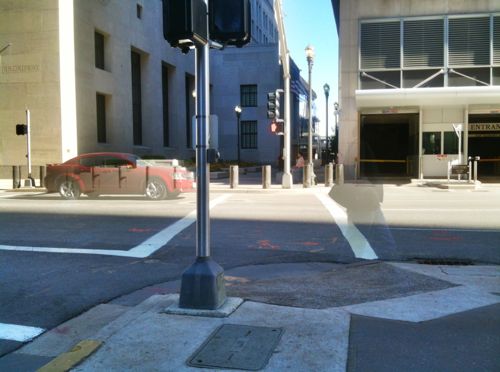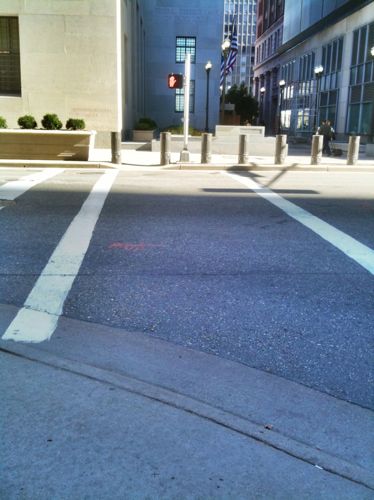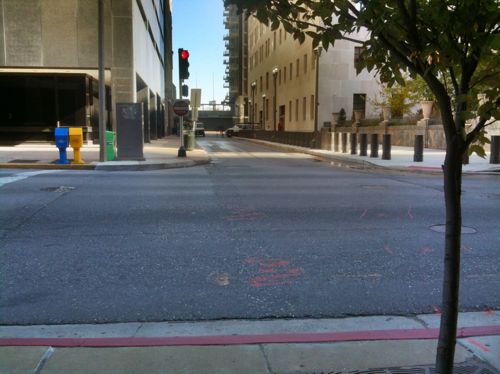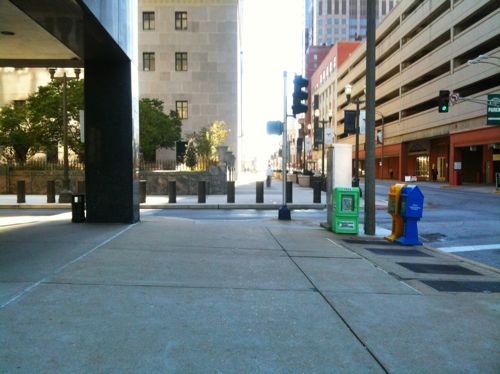Poorly Executed Pedestrian Access Around St. Louis Federal Reserve
Yesterday I posted about the challenges crossing 4th Street at Locust (Crosswalks & Curb Ramps Needed at 4th & Locust) to get to the Federal Reserve. Â Today I want to share problems with crossing Broadway (5th) at Locust and St. Charles at Broadway to reach the Federal Reserve.

The situation, above, differs from 4th in that here a crosswalk exists on the pavement. Â However, there is no curb ramp on the far side. Like 4th, this was done when the Federal Reserve took over this block of Locust for their pedestrian plaza.
From the Post-Dispatch on December 11, 2003:
A $13 MILLION PLAN to restore the Security Building took an important step forward — and so it seems did a proposed $90 million investment by the 500-pound gorilla next door, the Federal Reserve. … The designs for the Security Building, by the way, revealed another interesting transformation: a Fed plan to replace Locust Street between Fourth and Broadway with a pedestrian plaza.
So the Federal Reserve spent $90 million but they couldn’t include a couple of curb ramps in newly poured concrete?  Unacceptable!  But in November 2005 the Downtown St. Louis Partnership (now Partnership for Downtown St. Louis) gave the Federal Reserve an award for the plaza.

There is one spot where both ends of the crosswalk have curb ramps, shown above. Â Recently the Federal Reserve completed their expansion, which included a new sidewalk along St. Charles St.

On the right you will see a curb ramp at the corner of the new work by the Federal Reserve. Â Not sure where someone is supposed to go from there. Â The detectable warnings direct the blind into the middle of the intersection. Â I suppose someone could cross Broadway since an exit from a parking garage could serve as a dangerous curb ramp on this side of Broadway.

When trying to cross St. Charles there is a curb ramp on this side of the street, between the building corner and the traffic signal. Â However, the ramp for the other side is way out at the corner, hidden from view by the blue & yellow boxes. Â Brilliant! Â I guess for only $90 million you can’t expect much?
Keep in mind that others, such as parents with strollers, use curb ramps. Â These issues are personally frustrating to me but they make St. Louis less than ideal for all pedestrians.
– Steve Patterson
As is usual in St. Louis, the streets are completely empty in these pictures. It's hard to make the case for building a pedestrian-friendly city when there are no pedestrians.
Ever wonder why they are empty? We have environments that are hostile to pedestrians!
We have an environment that does not welcome pedestrians. The racial differences in the City are astounding. I'm awaiting Detroit-style riots that will be the end of the City.
I am confused as to why the detectable warning panels have to be aligned for the blind. If a blind person ever locates a detectable warning panel, how are they to tell which direction the panel is orientated? I would imagine that I would just locates the circular raised portions of the panel with no perception of how it is aligned with the adjacent roadway. From what I've read, I would use my ears to locate where the traffic is travelling…
First, I understand and support the ADA and its (and your) goal of universal access. That said, we need to remember that curbs actually do serve a real purpose and work better than ramps for the vast majority of us. Gutters have one purpose, to channel rain water and melting snow and to leave drier places to walk and drive. Curbs define and separate the pedestrian and vehicular realms. Curbs make gutters deeper and allow whatever water flow to be narrower and easier to step over. Ramps do just the opposite, they typically double the width of the flowing water, making it much harder to step over. What it boils down to is a no-win choice between wet feet or wet wheels.
Curb ramps can also create a trip hazard, for both the visually impaired and for the plain distracted person, when the path of travel is more than a simple bi-directional path, especially at intersections. This is less of a problem when sidewalks have a tree lawn and are set back from the curb. It's a bigger challenge in more urban areas, like those shown in these examples.
Ideally, we should accomodate everyone, with a parallel system of curb ramps and curbs – “one size” simply won't fit everyone. That said, I fully agree that putting ramps on one side of an intersection and not on the other is both stupid and frustrating, and I agree that ALL new work should meet current standards. There just needs to be balance. Your needs while using a cane are different than when using your electric scooter. A working mother's needs are different when she's pushing a stroller on the weekend or rushing to catch a bus home in the rain after work . . .
Spend any amount of time downtown observing pedestrians and you will see that able-bodied pedestrians often use the ramps even though they are not placed in their direct line of travel.
I see dead people in that first photo.
Glad I'm not the only one…